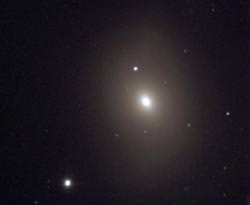Astronomers know of several kinds of explosions in space. Supernovae occur when massive stars detonate or become black holes. Gamma ray bursts occur for certain kinds of supernovae, or the collision between compact objects, like neutron stars. And novae happen when stellar material piles up on the surface of a star or white dwarf, and then detonates. But now it looks like a new class of explosions have been identified: a red luminous nova.
The explosive event was discovered in a nearby galaxy in the Virgo cluster called Messier 85. Astronomers watched a star flare up, not as bright as a supernova, but much brighter than a nova. Instead of a quick flash, it brightened up much more slowly, with a distinctive red colour.
Astronomers speculate that the explosion occurred when two ordinary stars in a binary system finally came together, undergoing a process called “common envelope evolution”.
The cooling afterglow of the explosion was too dim to see in Hubble, but it was still bright enough in the infrared spectrum to see with the Spitzer Space Telescope. There’s little doubt that it’s a new class of object, and now astronomers will be fine tuning their searches to turn up more objects like this.
Original Source: Caltech News Release

